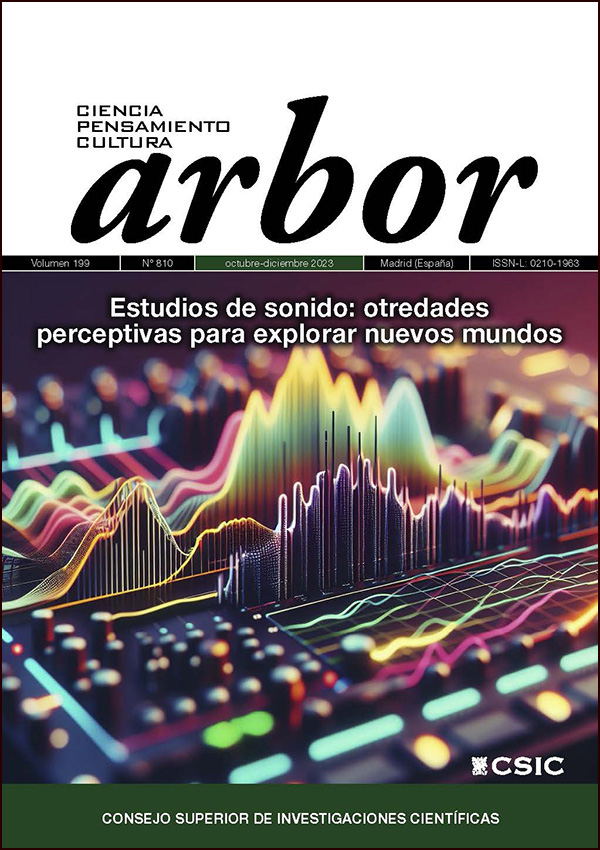Aural ecology: a categorical investigation in self-organizing systems
DOI:
https://doi.org/10.3989/arbor.2023.810007Keywords:
ontology, self-organization, categories, ecology, auralityAbstract
In this work we explain the philosophical analysis of the modal categories oriented toward the study and understanding of self-organizing systems showing complexity. For this, we focus our research in the area of ecology and, more specifically, in the field of aural ecology, that is, in the study of the sounds that make up ecosystems. The modal categories developed here are, firstly, «repertoriality», referring to the coherence and internal stability of any self-organizing system; then, «dispositionality», or the experimentation and variation inherent in these systems and, finally, the «landscape», regarding what is really effective, what is given. This conjunction of categories leads us to explore the modal system of necessity-contingency-possibility-impossibility which, applied to sound studies, becomes the game of signals-redundancy-noise-silence. These categories, applied to real instances found in natural environments, help us to understand the way Heraclitus’s becoming is revealed in every ecosystem. Finally, we discover how the categorical investigation of soundscapes provides us with complex information about the evolutionary behaviour and the state of conservation of these systems.
Downloads
References
Amorim, M. Clara P. (2006). Diversity of sound production in fish. Communication in fishes, 1, 71-104.
Buckminster Fuller, Richard (1975). Synergetics: Explorations in the Geometry of Thinking. Nueva York: MacMillan Press.
Carson, Rachel (1962). Silent spring. Boston: Houghton Mifflin.
Claramonte, Jordi (2016). Estética Modal: Libro Primero. Madrid: Tecnos (Grupo Anaya, S.A.).
Claramonte, Jordi (2021). Estética Modal: Libro Segundo. Madrid: Tecnos (Grupo Anaya, S.A.).
De Unamuno, Miguel (1924). Teresa. Madrid: Renacimiento.
Duarte, Carlos M.; Chapuis, Lucille; Collin, Shaun P.; et al. (2021). The soundscape of the Anthropocene ocean. Science, 371(6529), eaba4658. https://doi.org/10.1126/science.aba4658 PMid:33542110
Gómez-Jauregui, Valentín; Carrillo-Rodríguez, Ángela; Manchado, Cristina y Lastra-González, Pedro (2023). Tensegrity Applications to Architecture, Engineering and Robotics: A Review. Applied Sciences, 13(15), 8669. https://doi.org/10.3390/app13158669
Hartmann, Nicolai (1959). Ontología vol. III. México D. F.: Fondo De Cultura Económica.
Hernández-Brito, Dailos; Carrete, Martina; Ibáñez, Carlos; Juste, Javier y Tella, José L. (2018). Nest-site competition and killing by invasive parakeets cause the decline of a threatened bat population. Royal Society Open Science, 5(5), 172477. https://doi.org/10.1098/rsos.172477 PMid:29892437 PMCid:PMC5990744
Jantsch, Erich (1980). The Self-organizing Universe: Scientific and Human Implications of the Emerging Paradigm of Evolution. Nueva York: Pergamon Press.
Kauffman, Stuart (1983). The Origins of Order: Self-organization and Selection in Evolution. Nueva York: Oxford University Press.
Krause, Bernard L. (1993). The niche hypothesis: a virtual symphony of animal sounds, the origins of musical expression and the health of habitats. The Soundscape Newsletter, 6, 6-10
Llusía, Diego (2012). Comunicación acústica en anuros ibéricos. Influencia del clima, hábitat y ambiente sonoro. (Tesis doctoral inédita). Universidad Autónoma de Madrid, Madrid.
Lotka, Alfred J. (1925). Elements of Physical Biology. Baltimore: Wilkins & Wilkins.
Maxwell, James Clerk (1890). The scientific papers of James Clerk Maxwell. Nueva York: William Davidson Niven.
Morin, Edgar (1986). El Método, La naturaleza de la naturaleza. Madrid: Ediciones Cátedra, SA.
Nicolis, Gregoire y Prigogine, Ilya (1977). Self-Organization in Non-Equilibrium Systems. Nueva York: Wiley & Sons.
Odum, Eugene P. (1953). Fundamentals of Ecology. Londres: W.B. Saunders Company.
Solé, Ricard y Goodwin, Brian (2001). Signs of Life: How Complexity Pervades Biology. Nueva York: Basic Books
SEO/BirdLife (20 de julio 2022). Los charrancitos vuelven a criar en la Desembocadura del Río Mijares 32 años después. Disponible en: https://seo.org/2022/07/26/los-charrancitos-vuelven-a-criar-en-la-desembocadura-del-rio-mijares-32-anos-despues/?fbclid=IwAR2eCl4gYvr-6AcfYqTvUH4u_iDGkcO3Md6q6i8wFn-iHw8SPuVRhJ6SzGw
Stafford, Kathleen Mary; Lydersen, Christian; Wiig, Øistein y Kovacs, Kit M. (2018). Extreme diversity in the songs of Spitsbergen's bowhead whales. Biology letters, 14(4), 20180056. https://doi.org/10.1098/rsbl.2018.0056 PMid:29618521 PMCid:PMC5938564
Thompson, D'Arcy Wentworth (1917). On growth and form. Cambridge: Cambridge University Press
Viciosa, Mario (5 de abril de 2018). La ballena que canta 'Jazz'. El Independiente. Disponible en: https://www.elindependiente.com/futuro/2018/04/05/la-ballena-que-canta-jazz/.
Additional Files
Published
How to Cite
Issue
Section
License
Copyright (c) 2024 Consejo Superior de Investigaciones Científicas (CSIC)

This work is licensed under a Creative Commons Attribution 4.0 International License.
© CSIC. Manuscripts published in both the printed and online versions of this Journal are the property of Consejo Superior de Investigaciones Científicas, and quoting this source is a requirement for any partial or full reproduction.
All contents of this electronic edition, except where otherwise noted, are distributed under a “Creative Commons Attribution 4.0 International” (CC BY 4.0) License. You may read the basic information and the legal text of the license. The indication of the CC BY 4.0 License must be expressly stated in this way when necessary.
Self-archiving in repositories, personal webpages or similar, of any version other than the published by the Editor, is not allowed.














